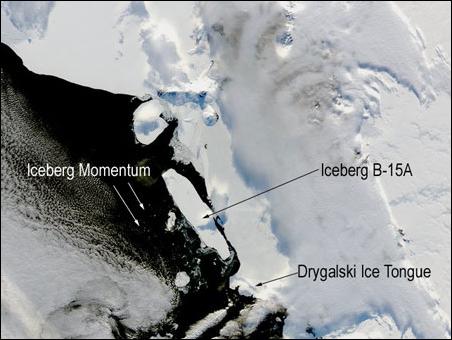NASA: Slow-Motion Collision Near McMurdo Imminent
Scientists say Slow-Motion Collision Near Antarctic Research Station Imminent
It is an event so large that the best seat in the house is in space: a massive iceberg is on a collision course with a floating glacier near the McMurdo Research Station in Antarctica. NASA satellites have witnessed the 100-mile-long B-15A iceberg moving steadily towards the Drygalski Ice Tongue. Though the iceberg's pace has slowed in recent days, NASA scientists expect a collision to occur no later than January 15, 2005.

The MODIS instrument on NASA’s Aqua and Terra satellites captured 13 images of the shifting B-15A iceberg between November 9 and January 2, 2005. The Iceberg is also compared to the size of Long Island, New York.
"It's a clash of the titans, a radical and uncommon event," says Robert Bindshadler, a researcher at NASA's Goddard Space Flight Center, and if the two giant slabs of ice collide, we could see one of the best demolition derbies on the planet. "Even a 'tap' from a giant can be powerful. It will certainly be a blow far larger than anything else the ice tongue has ever experienced," says Bindshadler.
When the iceberg and the ice tongue collide, the impact will likely "dent their bumpers," says Bindshadler. The edges could crumple and ice could pile or drift into the Ross Sea. But if the B-15A iceberg picks up enough speed before the two collide, the results could be more spectacular. The Drygalski Ice Tongue could break off.
The ice tongue is thick ice that grows out over the Ross Sea from a land-based glacier on Antarctica's Scott Coast. "Ice tongues do break off on occasion," says Bindshadler. "It would only take one thin area on the ice tongue to make it break off." There's no guarantee that the Drygalski Ice Tongue will break off, but "this is the toughest blow it has ever had to deal with."
"That Ice tongue has no reason for staying intact" says Waleed Abdalati, researcher with NASA's Goddard Space Flight Center, but Bindshadler points out, it may not break up either. The results depend on the movement of the B-15A iceberg.
The B-15A iceberg is a 3,000-square-kilometer (1,200-square-mile) behemoth that has a history of causing problems. It is the largest fragment of a much larger iceberg that broke away from the Ross Ice Shelf in March 2000. Scientists believe that the enormous piece of ice broke away as part of a long-term natural cycle (every 50-to-100 years, or so) in which the shelf, which is roughly the size of Texas, sheds pieces much as human fingernails grow and break off.
The berg initially drifted toward McMurdo Sound and grounded near Cape Crozier on Ross Island. It has since broken into pieces, the largest of which is B-15A.
This year, B-15A has trapped sea ice in McMurdo Sound. The currents that normally break the ice into pieces and sweep it out into the Ross Sea have not been able to clean out the Sound, so winter's thick ice remains intact.
The build-up of ice presents significant problems for Antarctic residents. Penguins must now swim great distances to reach open waters and food. Adult penguins may not be able to make the trip and return with food for their young. As a result, many chicks could starve, says Antarctica New Zealand, the government organization that oversees New Zealand's Antarctic research, in the Associated Press.
The National Science Foundation (NSF) officials said that the B-15A iceberg and the frozen Sound will not interfere with supply ship access to McMurdo Station, the U. S. logistics hub for much of the nation's research activity in Antarctica. Forty miles of ice typically separate the pier at McMurdo from the open sea, but this year the ice stretched 80 miles from the station. So far, the extra ice has not been a problem. The U.S. Coast Guard icebreaker Polar Star left Seattle, Washington, on Nov. 4 and docked at McMurdo in early January after cutting a channel through the ice for supply ships.
Ironically, a collision between the iceberg and the ice tongue could make things easier for both penguins and ships. If the ice tongue collapses, the way may be opened for sea ice to escape the Sound.
There is no guarantee that satellite will see a great demolition because the berg's fate is unclear. The berg's future depends on unpredictable winds, tides and other forces, but possibilities include colliding with the floating Drygalski Ice Tongue, or continuing north, eventually melting.
If the collision occurs as
predicted, this could be an event that we witness again and
again. The tides that drive the iceberg's motion tend to
push it in circles. "If B-15A bangs the ice tongue once, it
could bang it again," says Bindshadler. With multiple daily
views of the Ross Sea, NASA satellites will be there to
watch the show.


 Stats NZ: Annual Number Of Home Consents Down 7.4 Percent
Stats NZ: Annual Number Of Home Consents Down 7.4 Percent Plains Media: Plains FM Announces Name Change After 37 Years
Plains Media: Plains FM Announces Name Change After 37 Years NIWA: Flooding From Underneath - New Tool Reveals Shallow Groundwater Elevations
NIWA: Flooding From Underneath - New Tool Reveals Shallow Groundwater Elevations Commerce Commission: Commission Concludes Auckland Airport Over-charging By $190 Million
Commerce Commission: Commission Concludes Auckland Airport Over-charging By $190 Million The Future Is Rail: Ferry Decision - Common Sense Prevails
The Future Is Rail: Ferry Decision - Common Sense Prevails Aotearoa Food Rescue Alliance: Grocery Market Reform Must Include Mandatory Food Rescue Partnerships
Aotearoa Food Rescue Alliance: Grocery Market Reform Must Include Mandatory Food Rescue Partnerships



